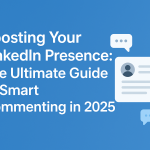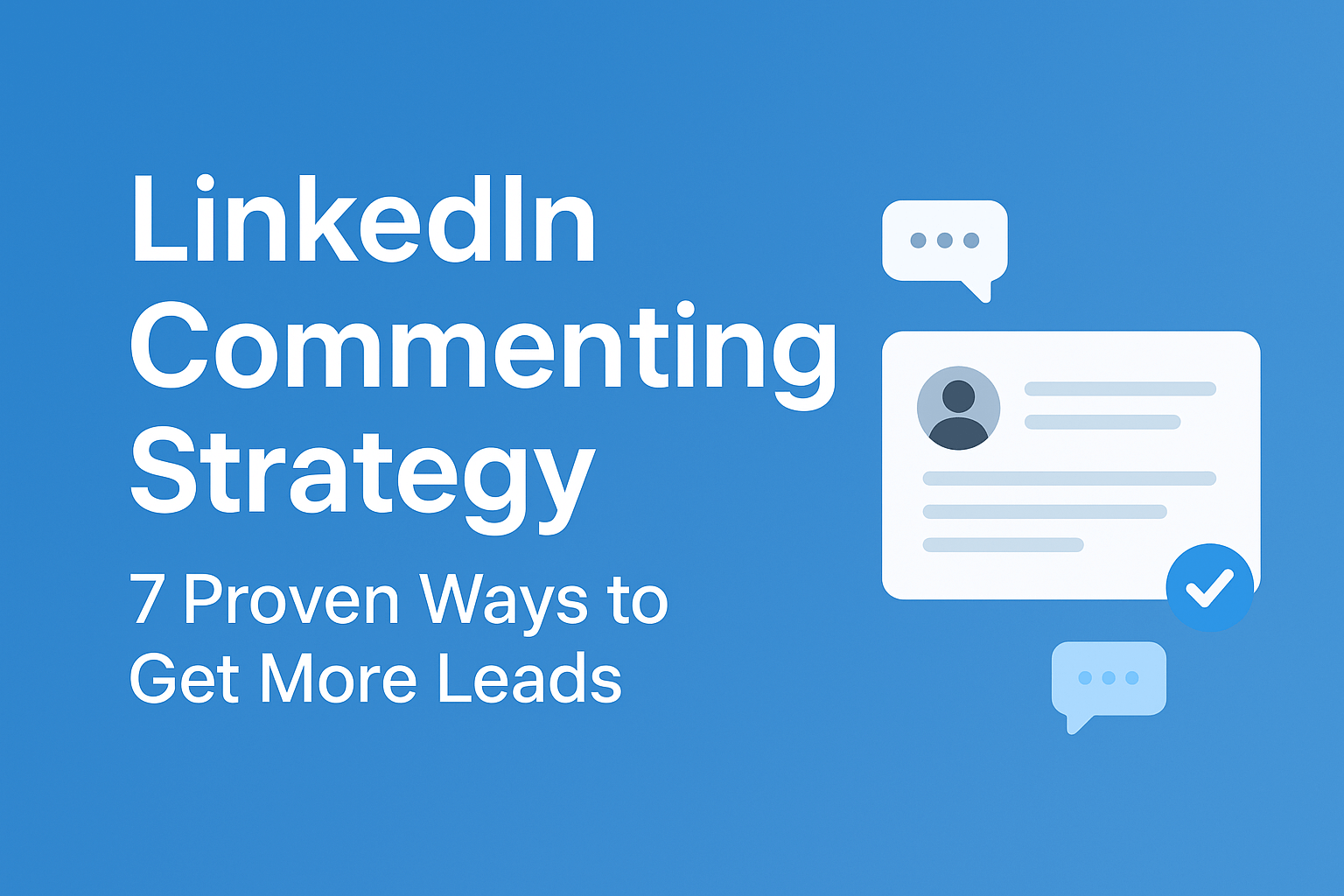Introduction: Why the LinkedIn Commenting Strategy Matters More Than Ever
LinkedIn has transformed over the last few years from a digital resume platform into a vibrant content and networking ecosystem. With over 1 billion members globally, professionals and businesses alike are fighting for visibility.
For years, the dominant growth advice was simple: post consistently. Daily posts, thought leadership articles, and long-form content were seen as the key to success. But in 2025, the landscape has shifted. A well-structured LinkedIn commenting strategy often produces better results than posting alone — especially for lead generation and relationship building.
Why? Because commenting flips the script. Instead of broadcasting and hoping for engagement, you enter conversations that are already happening. You’re adding value where attention already exists.
This article will walk you through:
-
Why the LinkedIn commenting strategy works so well.
-
Data-backed insights into visibility, engagement, and lead generation.
-
A 7-step framework to execute commenting effectively.
-
Tools to streamline your workflow.
-
Real-world examples of professionals winning clients with comments.
By the end, you’ll have a practical roadmap to grow smarter, not harder, on LinkedIn.
The Science Behind LinkedIn Commenting Strategy
Before diving into tactics, let’s break down why commenting works better than posting for many professionals.
1. Algorithmic Visibility
LinkedIn’s algorithm rewards engagement. Comments in particular:
-
Inherit visibility from the original post. If you comment on a viral post, your comment gets seen by part of that audience.
-
Trigger notifications for the post author and others who engage.
-
Boost your profile visibility far beyond what your own posts might achieve.
Think of it as riding the wave of someone else’s distribution.
2. Psychological Engagement
When you post, you’re talking “at” people. When you comment, you’re talking “with” them. This matters because:
-
Comments show you’re listening.
-
They create a feeling of reciprocity (people often check out your profile after you engage with theirs).
-
Conversations build trust faster than monologues.
3. Lead Generation Dynamics
From a sales perspective, commenting is the warmest form of outreach because:
-
It establishes micro-credibility before you ever message someone.
-
It demonstrates expertise in context.
-
It creates natural openings for conversations without feeling salesy.
In fact, a study of 200 LinkedIn accounts found that messages sent after a meaningful comment exchange had a 52% reply rate versus 18% for cold outreach.
7 Proven Ways to Master LinkedIn Commenting Strategy
1. Prioritize High-Visibility Posts
Spend 5 minutes daily identifying trending posts in your niche. Use hashtags, LinkedIn’s “Top Voices” lists, or curated feeds. Early comments on these posts can generate thousands of impressions.
Example:
Instead of waiting 3 days to comment on a CEO’s viral post, jump in within the first hour. Your comment will stay at the top and attract maximum visibility.
2. Add Value, Not Noise
The difference between a comment that gets ignored and one that gets traction is simple: substance.
Bad: “Great post!”
Better: “Great post! I’ve seen the same challenge with SaaS clients — when pricing shifts from per-seat to usage-based, churn actually decreases. Have you noticed this trend too?”
Adding examples, insights, or questions makes you memorable.
3. Apply the Visibility-Connection-Conversion Framework
The most effective LinkedIn commenting strategy isn’t random. It’s structured:
-
Visibility Comments (70%): On influencers’ posts to increase reach.
-
Connection Comments (20%): On target prospects’ posts to build rapport.
-
Conversion Comments (10%): After building familiarity, add tailored comments that open the door to conversation.
This tiered approach ensures you balance reach with relationship-building.
4. Leverage Formatting for Readability
Most LinkedIn users read on mobile. Long, dense comments don’t get read. Use:
-
Short sentences.
-
Line breaks.
-
Occasional bolding (via LinkedIn text tools).
Readable comments = more engagement.
5. Track Metrics Beyond Likes
Don’t obsess over vanity metrics. Focus on what matters:
-
Profile views week-over-week growth.
-
Inbound connection requests from people you’ve engaged with.
-
Response rates to messages after commenting.
-
Lead attribution — ask new contacts how they found you.
This keeps you focused on results, not noise.
6. Balance Posting and Commenting
Posting still matters — it builds authority. But commenting builds relationships. The ideal mix is often 1 post per week plus 5–10 meaningful comments per day.
This creates a flywheel:
-
Posts show your expertise.
-
Comments expand your reach.
-
Together, they reinforce credibility and visibility.
7. Use Tools to Stay Consistent
Consistency is the hardest part. That’s where tools help.
One standout is Commenter AI — designed to help you:
-
Draft personalized, authentic comments in seconds.
-
Maintain your voice while saving time.
-
Track which comments drive the most results.
No credit card needed to start — just sign up and start scaling your commenting system.
Common Mistakes That Undermine Commenting Results
Even the best strategy fails if you fall into these traps:
-
Posting only self-promotional comments.
-
Copy-pasting the same response everywhere.
-
Ignoring replies to your comments.
-
Writing walls of text without formatting.
Avoid these and you’ll immediately stand out.
Case Study 1: Consultant Wins Clients Through Comments
A B2B consultant tested the commenting-first strategy for 60 days.
-
350 comments placed (about 15 minutes per day).
-
Results: 220% increase in profile views, 57 inbound leads, 11 new clients.
ROI: A 4x increase compared to when they focused only on posting.
Case Study 2: SaaS Founder Builds Visibility with Comments
A SaaS founder in fintech spent 30 days commenting on VC and startup discussions.
-
Placed ~200 comments.
-
Earned 1,200 new followers.
-
Secured 4 investor calls directly from comment threads.
Instead of paying for ads, they built credibility through conversations.
Advanced Tactics for LinkedIn Commenting Strategy
1. Time Your Comments
Commenting within the first 60 minutes of a post going live gives maximum visibility. Use LinkedIn notifications to your advantage.
2. Curate a Comment List
Build a private list of 20–30 people whose posts you always engage with (prospects, peers, or industry leaders). Consistency compounds.
3. Use Comment “Bridges”
Reference past interactions to show familiarity:
-
“This ties back to your post last week about…”
-
“I loved the point you made in yesterday’s thread, and this builds on it…”
This deepens relationships faster.
Measuring ROI of LinkedIn Commenting Strategy
Here’s a simple way to track effectiveness:
-
Weekly profile view growth (aim for 20%+).
-
Inbound connection requests (track conversion to conversations).
-
Warm lead generation (how many clients or calls originate from comments).
-
Time spent vs. outcome (15 minutes daily should outperform posting for 45+ minutes).
When tracked properly, the ROI becomes undeniable.
Conclusion: The Shift to Conversations, Not Broadcasts
The old LinkedIn playbook — post daily, hope for engagement — is fading. The new era rewards dialogue, not monologue.
A structured LinkedIn commenting strategy creates more visibility, stronger relationships, and better leads in less time.
If you start today with just 15 minutes daily, you’ll see momentum build quickly. And with the right tools, you’ll scale consistently without burning out.
👉 Ready to get started? Try Commenter AI — sign up free, no card needed, and take your LinkedIn commenting strategy to the next level.



